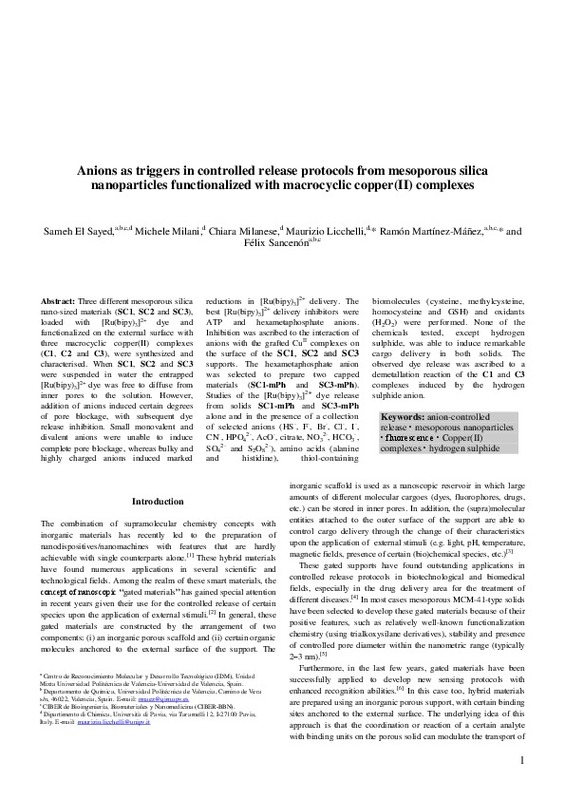JavaScript is disabled for your browser. Some features of this site may not work without it.
Buscar en RiuNet
Listar
Mi cuenta
Estadísticas
Ayuda RiuNet
Admin. UPV
Anions as Triggers in Controlled Release Protocols from Mesoporous Silica Nanoparticles Functionalized with Macrocyclic Copper(II) Complexes
Mostrar el registro sencillo del ítem
Ficheros en el ítem
| dc.contributor.author | El Sayed Shehata Nasr, Sameh
|
es_ES |
| dc.contributor.author | Milani, Michele
|
es_ES |
| dc.contributor.author | Milanese,Chiara
|
es_ES |
| dc.contributor.author | Licchelli, Maurizio
|
es_ES |
| dc.contributor.author | Martínez-Máñez, Ramón
|
es_ES |
| dc.contributor.author | Sancenón Galarza, Félix
|
es_ES |
| dc.date.accessioned | 2017-04-04T15:31:52Z | |
| dc.date.available | 2017-04-04T15:31:52Z | |
| dc.date.issued | 2016-09 | |
| dc.identifier.issn | 0947-6539 | |
| dc.identifier.uri | http://hdl.handle.net/10251/79448 | |
| dc.description.abstract | Three different mesoporous silica nano-sized materials (SC1, SC2, and SC3), loaded with [Ru(bipy)(3)](2+) dye (bipy= bipyridine) and functionalized on the external surface with three macrocyclic copper(II) complexes (C1, C2, and C3), were synthesized and characterized. When SC1, SC2, and SC3 were suspended in water, the entrapped [Ru(bipy)(3)](2+) dye was free to diffuse from the inner pores to the solution. However, addition of anions induced certain degrees of pore blockage, with subsequent dye release inhibition. Small monovalent and divalent anions were unable to induce complete pore blockage, whereas bulky and highly charged anions induced marked reductions in [Ru(bipy)(3)](2+) delivery. The best [Ru(bipy)(3)](2+) delivery inhibitors were ATP and hexametaphosphate anions. Inhibition was ascribed to the interaction of the anions with the grafted Cu-II complexes on the surface of the SC1, SC2, and SC3 supports. The hexametaphosphate anion was selected to prepare two capped materials (SC1-mPh and SC3-mPh). Studies of the [Ru(bipy)(3)](2+) dye release from solids SC1-mPh and SC3-mPh alone and in the presence of a collection of selected anions (HS-, F-, Br-, Cl-, I-, CN-, HPO42-, AcO-, citrate, NO32-, HCO3-, SO42-, and S2O82-), amino acids (alanine and histidine), thiol-containing biomolecules (cysteine, methylcysteine, homocysteine, and glutathione (GSH)), and oxidants (H2O2) were performed. None of the chemicals tested, except hydrogen sulphide, was able to induce remarkable cargo delivery in both solids. The observed dye release was ascribed to a demetalation reaction of the C1 and C3 complexes induced by the hydrogen sulphide anion. | es_ES |
| dc.description.sponsorship | Financial support from the Spanish Government (Project MAT2012-38429-C04-01) and the Generalitat Valencia (Project PROMETEO/2009/016) is gratefully acknowledged. | en_EN |
| dc.language | Inglés | es_ES |
| dc.publisher | Wiley | es_ES |
| dc.relation.ispartof | Chemistry - A European Journal | es_ES |
| dc.rights | Reserva de todos los derechos | es_ES |
| dc.subject | anion-controlled release | es_ES |
| dc.subject | copper | es_ES |
| dc.subject | fluorescence | es_ES |
| dc.subject | hydrogen sulphide | es_ES |
| dc.subject | mesoporous nanoparticles | es_ES |
| dc.subject.classification | QUIMICA INORGANICA | es_ES |
| dc.subject.classification | QUIMICA ORGANICA | es_ES |
| dc.title | Anions as Triggers in Controlled Release Protocols from Mesoporous Silica Nanoparticles Functionalized with Macrocyclic Copper(II) Complexes | es_ES |
| dc.type | Artículo | es_ES |
| dc.identifier.doi | 10.1002/chem.201601024 | |
| dc.relation.projectID | info:eu-repo/grantAgreement/MINECO//MAT2012-38429-C04-01/ES/DESARROLLO DE MATERIALES FUNCIONALIZADOS CON PUERTAS NANOSCOPICAS PARA APLICACIONES DE LIBERACION CONTROLADA Y SENSORES PARA LA DETECCION DE NITRATO AMONICO, SULFIDRICO Y CO/ | es_ES |
| dc.relation.projectID | info:eu-repo/grantAgreement/Generalitat Valenciana//PROMETEO09%2F2009%2F016/ES/Ayuda prometeo 2009 para el grupo de diseño y desarrollo de sensores/ | es_ES |
| dc.rights.accessRights | Abierto | es_ES |
| dc.contributor.affiliation | Universitat Politècnica de València. Escuela Técnica Superior de Ingenieros Industriales - Escola Tècnica Superior d'Enginyers Industrials | es_ES |
| dc.contributor.affiliation | Universitat Politècnica de València. Instituto de Reconocimiento Molecular y Desarrollo Tecnológico - Institut de Reconeixement Molecular i Desenvolupament Tecnològic | es_ES |
| dc.description.bibliographicCitation | El Sayed Shehata Nasr, S.; Milani, M.; Milanese, C.; Licchelli, M.; Martínez-Máñez, R.; Sancenón Galarza, F. (2016). Anions as Triggers in Controlled Release Protocols from Mesoporous Silica Nanoparticles Functionalized with Macrocyclic Copper(II) Complexes. Chemistry - A European Journal. 22(39):13935-13945. https://doi.org/10.1002/chem.201601024 | es_ES |
| dc.description.accrualMethod | S | es_ES |
| dc.relation.publisherversion | http://dx.doi.org/10.1002/chem.201601024 | es_ES |
| dc.description.upvformatpinicio | 13935 | es_ES |
| dc.description.upvformatpfin | 13945 | es_ES |
| dc.type.version | info:eu-repo/semantics/publishedVersion | es_ES |
| dc.description.volume | 22 | es_ES |
| dc.description.issue | 39 | es_ES |
| dc.relation.senia | 318225 | es_ES |
| dc.identifier.eissn | 1521-3765 | |
| dc.contributor.funder | Generalitat Valenciana | es_ES |
| dc.contributor.funder | Ministerio de Economía y Competitividad | es_ES |






![[Cerrado]](/themes/UPV/images/candado.png)


